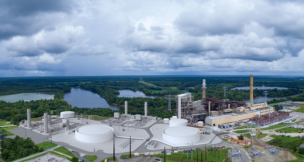Going greener
Port of Virginia sets 2040 net-zero carbon emissions goal
Going greener
Port of Virginia sets 2040 net-zero carbon emissions goal
The Port of Virginia is preparing for a greener future that includes less reliance on fossil fuels. It’s doing this by expanding its access to cleaner energy such as solar power; replacing older, diesel-fueled equipment with hybrid and all-electric alternatives; and supporting the region’s burgeoning offshore wind industry.
In his April 2022 State of the Port address, Virginia Port Authority CEO and Executive Director Stephen A. Edwards announced a decarbonization target goal of port operations reaching net-zero emissions by 2040. That translates into a 65% reduction in greenhouse gas emissions in the next 17 years, according to the port.
Additionally, Edwards said he anticipates the port will be significantly early in reaching its goal for operations to run completely from carbon-free power sources by 2032.
The Virginia Port Authority approved a deal in May 2022 with the Virginia Department of Energy and Dominion Energy Inc. to expand the port’s access to renewable energy, primarily from Dominion solar farms. The agreement covers the power needs of the port’s Norfolk Harbor terminals, according to Port of Virginia spokesman Joe Harris, and provides for additional allocations from future alternative energy sources like offshore wind. And the Virginia Inland Port in Front Royal has been running on electricity produced by solar-power installations since January, thanks to a new agreement with Rappahannock Electric Cooperative.
The port now expects its terminals to be operating on 100% carbon-free power sources by 2024.
From electrifying operations and buying cranes to creating wetlands and nurturing the development of oyster reefs, the Port of Virginia views environmental sustainability through lenses big and small, Harris says. The port not only wants to be a better neighbor and corporate citizen, but it sees transitioning away from fossil fuels as also good for business, according to Harris.
Part of what’s driving the effort is to stay ahead of an industry trend, he says. The port’s customers — big cargo carriers and cargo owners such as big box retailers — are making similar moves and expect the same from those with whom they do business. “They want to be aligned in a green supply chain and we want to be in lockstep with them as this trend continues to gain momentum,” Harris says. Consumers are also seeking out companies doing business along greener lines.
“A lot of our effort, really over a decade, has been reducing our emissions from our own equipment, primarily via conversion to either electric or hybrid electric,” says Scott Whitehurst, the port’s director of environmental policy and compliance. Substation upgrades have been included in recent modernization projects.
Virginia International Gateway terminal, which is leased by the port, began a pilot program in 2015 with three hybrid diesel-electric shuttle carriers, used for loading, unloading and transporting containerized cargo. Now, 90 of the port’s 100 shuttle carriers in operation are hybrid, Whitehurst says. Each shuttle results in 90% lower nitrogen oxides emissions — a common source of industrial pollution — and 50% lower diesel fuel consumption compared with traditional diesel units, according to the port’s 2021 environmental sustainability report.
Another pilot program launched at Norfolk International Terminals last year resulted in the delivery of new all-electric yard tractors, which are used to transport containers around the terminal. Whitehurst says the tractors already are outperforming initial expectations.
The port also has replaced diesel-fueled ship-to-shore cranes with electric models.
“If you look at all of our equipment across both of our big container terminals, we’re hovering somewhere around a little over 50% of all equipment is either hybrid electric or electric right now,” Whitehurst says. “And that’s only going to grow.”
Since 2017, the Port of Virginia has reduced its fuel consumption by 42%, according to the 2021 environmental sustainability report. It’s also achieved a 30% reduction in greenhouse gas emissions.
Ian Gansler, American Association of Port Authorities’ manager of energy, resilience and sustainability policy, says examples of innovative green technologies can be found at ports across the country and run the gamut from hydrogen-powered dredge trucks to microgrids that enable port operations to continue in the face of power outages.
“[The] port industry is really on the cutting edge of implementing some really exciting technologies that are going to power the transportation freight industry for decades to come,” Gansler says. Members want to be leaders on energy and environmental issues, according to Gansler, but also recognize that sustainability efforts present economic opportunities.
Harris says the Port of Virginia is in a unique position to be the mid-Atlantic’s, if not the East Coast’s, logistics center for the offshore wind industry. The port’s Portsmouth Marine Terminal, he notes, is transitioning into an offshore wind hub where unfinished blades will be prepped for installation at Dominion’s Coastal Virginia Offshore Wind project off the coast of Virginia Beach.
The goal is to build on that momentum.
“It can truly be an entirely new industry for Virginia, and that industry can have its roots right here in Hampton Roads,” Harris says.
C














